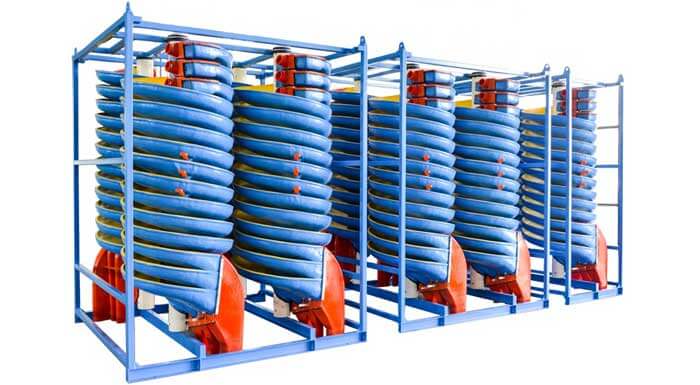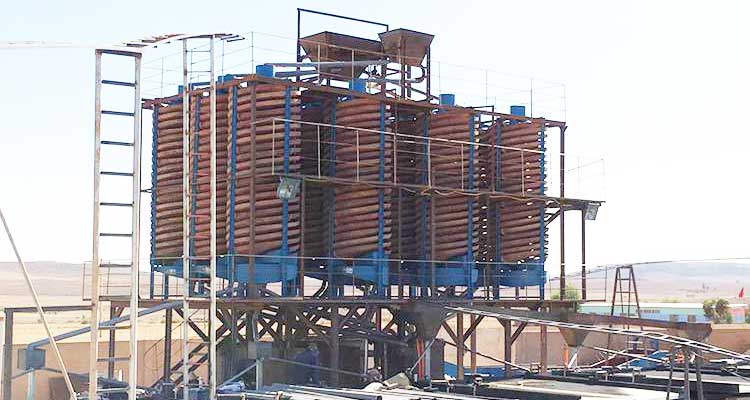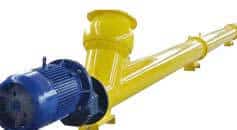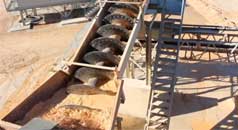Spiral Chute | Working Principle | Features | Specification

What is Spiral Chute
Spiral chute is a sorting equipment that separates concentrate and tailings based on the density and particle size of materials. Suitable for iron ore, ilmenite, chromite, pyrite, tungsten ore, tin ore, tantalum niobium ore, placer gold, zircon, rutile, monazite, phosphorite, and other non-ferrous metals, rare metals, and non-metallic minerals with a specific gravity difference of 0.3-0.02 millimeters. It can also be used for tailings pond re selection and disposal of large amounts of abandoned tailings.
Working Principle
When the slurry enters the spiral chute, the movement trajectories of materials with different particle sizes and densities in the spiral chute are different due to the combined effects of gravity, centrifugal force, friction force, and hydrodynamic pressure on light and heavy particles.
The final concentrate with high density and particle size is discharged at the inner edge of the spiral groove, while the tailings with low density and particle size are discharged at the outer edge of the spiral groove. Spiral chutes are commonly used equipment in mineral processing plants for classifying and selecting fine-grained minerals.
Structure Features

The spiral chute is composed of eight parts, including a mining hopper, a feeding groove, a spiral groove, a product cutting groove, a receiving groove, and a channel steel bracket (including a cross or triangular frame) motor, and a vibration motor. The specifications include diameters Φ 2000mm, Φ 1500mm, Φ 1200mm, Φ 900mm, Φ 600mm, etc.

1. Distributor Hopper
The ore distributor hopper is a slurry distribution device of a spiral chute, located at the top of the spiral chute. The ore distributor hopper is a fixed network pipe distributor, which evenly distributes the ore slurry from the four surrounding discharge pipes to the ore feeding trough using the positive pressure of the ore slurry inside the barrel.
2. Feed Tank
The feeding trough is located between the ore separator and the spiral trough. Its function is to buffer and stabilize the slurry from the ore separator, and then evenly and slowly feed it into the spiral trough along the tongue type feeding weir plate. The width of the feeding trough should be appropriate, otherwise it will affect the sorting effect.
3. Spiral Slot
The spiral groove is the main component of the spiral groove, and the mineral sorting process is completed within the spiral groove.
4. Product Intercepted Slot
The product intercepted slot is connected to the discharge end at the lower part of the spiral groove. The slurry after spiral chute sorting forms ore belts with different grades at the discharge end, and is intercepted into concentrate, intermediate ore, and tailings through the product intercepted slot.

5. Product Collection Funnel
The ore collection Funnel is a concentric circular cylinder that can collect the concentrate, intermediate ore, and tailings intercepted from four product intercepting tanks by category and guide them to the next operation. The slope of the bottom of the collection funnel should be greater than 25% to ensure the smooth discharge of concentrate, intermediate ore, and tailings.
6. Chute Bracket
Chute support refers to the pillars around the spiral slot and the upper cross shaped frame, which are made of channel steel to ensure sufficient strength. The cross shaped frame in the upper part not only supports the ore separation hopper, but also positions the four channel steel pillars.
7. Spiral Unit
According to different processing requirements, the screw unit can be made into different layers, including single head, double head, three head, and four head structures. Each spiral groove is composed of 4-5 spiral blades connected by bolts (which can also be added), and the spiral blades are made of fiberglass (fiberglass reinforced plastic). The selection surface of the spiral groove has a specially designed wear-resistant layer, which is coated with polyurethane rubber or epoxy resin mixed with diamond sand. It has the advantages of lightweight, sturdy, and durable.
Specification Parameters
Spiral Chute Applications
Spiral chutes are widely used in the field of mineral processing, mainly for mineral separation. The following are the applications of spiral chutes:
- 1. Spiral chutes can be used to separate various metal and non-metallic minerals, such as iron, copper, gold, silver, lead, zinc, quartz sand, calcite, limestone, graphite, marble, coal, etc.
- 2. Spiral chutes are suitable for handling ores with particle sizes between 0.3 and 0.02mm.
- 3. The spiral chute has a simple structure, small footprint, low investment, and fast efficiency, and is widely used in small mineral processing plants and laboratories.
- 4. The spiral chute can be used in conjunction with equipment such as ball mills and vibrating screens to form a complete beneficiation production line.
- 5. Spiral chutes are very suitable for sand mining on beaches, riverbanks, sandbanks, and streams.
How To Choose A Suitable Spiral Chute

When choosing a spiral chute, the following 7 tips can help you easily choose:
- 1. Mineral Properties: The density, magnetism, electrical properties, color, shape, and other characteristics of different minerals vary, and it is necessary to choose a suitable spiral chute based on specific mineral properties.
- 2. Mineral Particle Size: Different minerals with different particle sizes require different spiral chutes, and suitable spiral chutes need to be selected based on the particle size of the material.
- 3. Mineral Content: Different mineral contents require different spiral chutes, and suitable spiral chutes need to be selected based on the mineral content in the material.
- 4. Equipment Reliability: When selecting spiral chutes, it is necessary to consider the reliability of the equipment and choose equipment with reliable quality and stable performance.
- 5. Maintenance Cost: The maintenance cost of different models of spiral chutes varies, and it is necessary to choose a suitable spiral chute based on one’s own budget and needs.
- 6. Equipment Size: Different models of spiral chutes also have different sizes, and it is necessary to choose a suitable spiral chute based on your own site and space.
- 7. Energy Consumption: Different models of spiral chutes also have different energy consumption, and it is necessary to choose a suitable spiral chute based on one’s own energy needs and costs.
In actual production, selecting spiral chutes requires considering multiple factors and making the correct decision based on the mine situation.
 Screw Conveyor Features | Working Principle and Types
Screw Conveyor Features | Working Principle and Types Coal Dewatering Screen | Working Principle | Features
Coal Dewatering Screen | Working Principle | Features Cement Rotary Kiln | Structure & Working Principle | Types | Features
Cement Rotary Kiln | Structure & Working Principle | Types | Features Spiral Washers VS Spiral Classifiers
Spiral Washers VS Spiral Classifiers




The LZZG spiral chute has the advantages of reasonable structure, simple installation, stable sorting process, easy control, large allowable range of ore concentration variation, high enrichment ratio, high recovery rate, small footprint, and low water consumption. Its structure consists of six parts: a feeding homogenizer, a feeding trough, a spiral trough, a product cutting trough, a receiving hopper, and a trough support. Spiral blades are made of fiberglass, lightweight and sturdy, and durable.